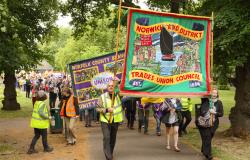Can New Tech Revive the World’s Trade Unions?

Duncan Green on the potential of technology to revitalise trade unions.
The Economist never ceases to surprise and inform. This week’s issue carries an excellent special report on ‘trade unions and technology’. Here’s an edited extract:

‘Support for organised labour is rising again (see chart). And technology may again play a central role in helping a revival—particularly in America, where activists are trying inventive new ways to organise workers.
Use of social media is taking the place of the shopfloor meeting in what is called “connective action”. Facebook, Reddit and WhatsApp, as well as tools such as Hustle, a texting service, allow labour groups to do three things: collect information, co-ordinate workers and get the word on campaigns out to the wider world.
Start with information. Although they work independently, many Uber drivers are active in chat groups and other online forums. The ride-hailing firm often tests new features of its app on a small group of drivers—without telling them what is going on. Online communications are an attempt to overcome this “information disadvantage”, says Alex Rosenblat, author of “Uberland”, a new book about the firm.
Comparing notes is also widespread among users of global crowdsourcing platforms such as Mechanical Turk and Freelancer, where digital labour is traded.
As for the second objective, co-ordination, without digital tools teachers’ strikes in West Virginia and other American states earlier this year would not have been as successful as they were, explains Jane McAlevey, a longtime organiser and author of several books on unions in America. In West Virginia teachers set up a Facebook group that was open only to invited colleagues. Nearly 70% of the state’s 35,000 teachers joined. The group became the hub of discussions on what to demand and how to organise protests.

The West Virginia strike is a good example of the third objective: getting the word out. The Facebook group turned into a factory for hashtags and “memes”, memorable images or video clips that spread virally online. The same sort of thing happened when Starbucks, a chain of coffee shops, refused to let baristas show their tattoos. Management caved in after employees took pictures of their body art and uploaded them to social media.
However, services such as Facebook and WhatsApp are not designed for mass activism. As a result, activists have started to develop digital services specifically for labour groups.
Coworker.org is an early instance. Founded in 2013, the website helps workers condense their demands in a petition and spread them on social media. Starbucks employees have launched several successful campaigns, and not only about tattoos. They pushed the firm to minimise “clopening”, for example—where the same person closes a store late in the evening and opens it at the crack of dawn the next day.
Coworker.org was long an isolated example. Recently similar services have flourished by mimicking the startup approach and “unbundling” the roles of official unions.
Some startups aim to fulfil the role of informing workers and recruiting members. Two years ago OUR launched WorkIT, a smartphone app for Walmart workers. After signing up, users are presented with a simple chat interface where they can ask questions about the retail chain’s complex workplace regulations. Volunteers, often Walmart employees themselves, answer.
Others concentrate on helping workers voice their opinions. Union bosses have often been criticised for not paying much heed to the rank-and-file’s demands. Workership is a platform that attempts to bring structure to often freewheeling discussions online and to enable employees to pipe up without fear of repercussions (posts are anonymous). Collective-bargaining agreements, for instance, are broken down into small segments which members can discuss.
Then comes finding ways to make money to finance activities. The Independent Workers Union of Great Britainhas resorted to crowdfunding its legal actions against Deliveroo, an online-delivery firm, which it accuses of having denied employment rights to its riders.
Some of these projects are spreading. WorkIT, which licenses its system to other labour organisations, has six takers, including the Pilipino Workers Centre in Los Angeles and United Voice, an Australian union. Coworker.org has been used by employees from more than 50 companies. For Starbucks it has become a union of sorts. Over 42,000 people in 30 countries are connected via the service.
Yet, as any startup will confirm, launching a new service is much easier than expanding one. Most of the fledgling
labour-tech projects rely on donations from philanthropists, socially minded investment funds and similar sources. It is not clear where the capital would come from to allow them to grow. In addition, these services lack the legal standing and political power of conventional unions.
Labour startups may need the support of existing unions if they are to turn into a force to be reckoned with. The best outcome would be if grassroots groups and conventional unions teamed up. Unions could become service providers for self-organising groups, helping them with things such as legal advice and lobbying.
The digital world has been embraced by some unions. Worried about the rise of crowd-working, Germany’s IGMetall, the country’s largest union, now allows self-employed workers to join. In 2015 it also launched a site to compare conditions on different crowdworking platforms, called Fair Crowd Work.
Some unions have even set up innovation units. One is HKLab, created a year ago by the National Union of Commercial and Clerical Employees, Denmark’s biggest union. Experiments include a chatbot for member inquiries and a service centre for freelancers. America’s National Domestic Workers Alliance operates Fair Care Labs, a service to improve the lot of nannies, carers and house cleaners. It will soon launch Alia, a portable-benefits service. Clients make voluntary payments of $5 per job, which allows cleaners to get some insurance coverage and paid time off.
However promising such projects, they are unlikely to help labour regain its erstwhile bargaining power soon. But if the digital labour movement has proven anything so far, it is that information and data are ever more powerful. Bad publicity is the digital equivalent of the picket line, says Michelle Miller, co-founder of Coworker.org.
Obtaining more and better data could give rise to what Fredrik Soderqvist of Unionen, a Swedish union, refers to as “predictive unionism”. His organisation is building a system that could mine information it has about its members as well as data from other sources. The idea is to offer services such as telling workers when they should ask for a raise. Algorithms could also predict the likelihood of lay-offs, if say a new chief executive takes over, and hence the need to get members ready to act.
For now, unions still look weak. Membership continues to decline. But their history shows that the relative power of labour and capital is constantly in flux. Recent decades have been tough on labour, largely as a consequence of technological change. But technology may also be the thing that helps turn their fortunes around.’
Duncan Green, strategic adviser for Oxfam GB, author of ‘How Change Happens’ and Professor in Practice at the London School of Economics.
This post first appeared on:
Image credit: Roger Blackwell via Flickr (CC BY 2.0)



